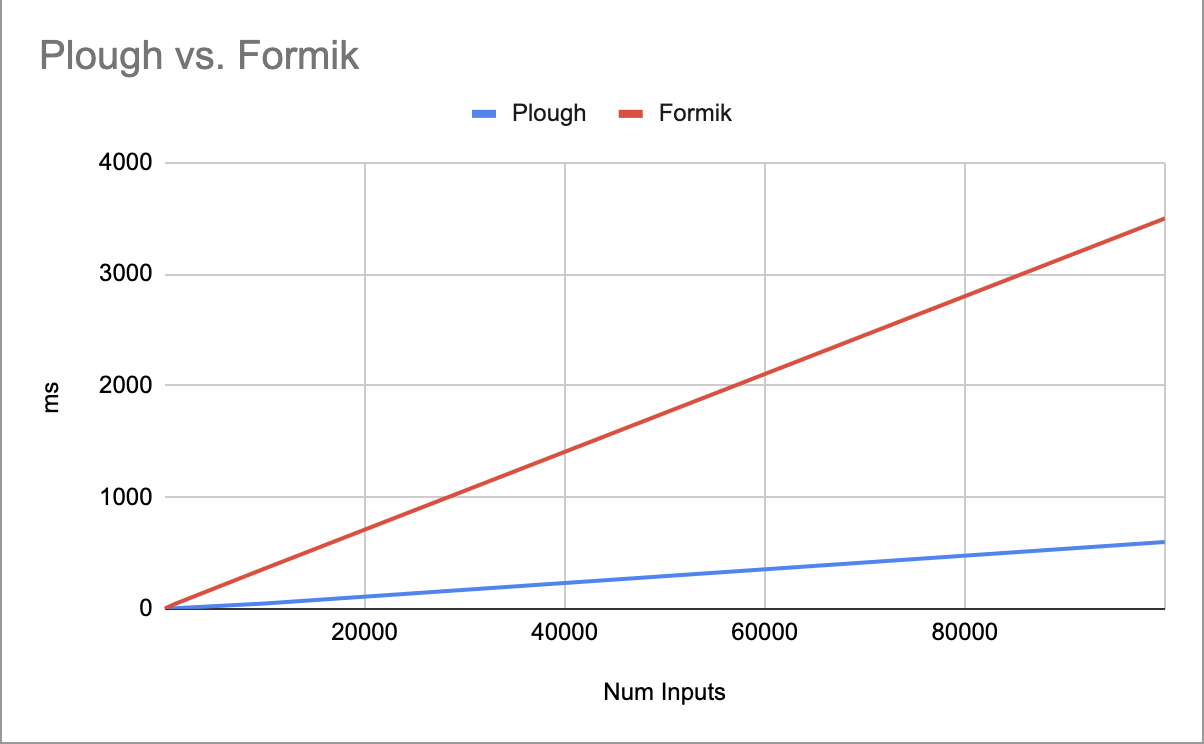react-plough v0.7.1
A library to help tend your react fields
yarn add react-plough
npm i react-ploughreact-plough is yet another react form library. It prioritises developer experience and aims to reduce user error by providing strongly typed and performant interfaces for react form fields. Unlike existing form libraries, plough does not use react context and does not require any manual type annotation. In other words, it is lightweight and hard to screw up.
ploughis 3 to 700x faster than Formik *(see bottom)
Play with the Formik comparison
Check out the Docs
Basic Usage
Plough views fields as the atomic unit of user-input and uses a familiar API, but is designed as a library, not a framework. As such, plough fits around your code, instead of fitting your code around itself. A basic example looks like:
import { useTextField } from "react-plough";
const LoginForm = () => {
const [nameProps, name] = useTextField({
validate: (name) =>
name.value.length === 0 ? "Name must be provided" : undefined,
});
const [passwordProps, password] = useTextField({
validate: (password) =>
password.value.length === 0 ? "Password is required" : undefined,
});
const handleSubmit = () => {
alert(`${name.value} ${password.value}`);
};
return (
<div>
<input {...nameProps} />
<input {...passwordProps} />
<button onClick={handleSubmit}></button>
</div>
);
};The fields are not dependent on each other and don't use any react context. This means it causes the minimum amount of re-renders, and gradual adoption is simple. In the basic case, plough acts like a glorified useState with some input-specific helpers.
However, forms often exist across several layers of the DOM tree, have lists of fields and have more complicated requirements. As such, opt-in utilities exist to enable complicated use-cases too.
A more realistic example
Bear in mind that all of the below is strongly typed -- no guessing or type annotation required
const form = createForm({
name: "",
age: "8", // HTML <input/> numbers are still strings
friendNames: [""],
});
export const ProfileForm = () => {
const [nameProps] = form.useName();
const [ageProps] = form.useAge({
validate: (val) => (Number(val) < 18 ? "Must be over 18" : undefined),
});
return (
<div>
<input {...nameProps} />
<input {...ageProps} type="number" />
<FriendForm />
</div>
);
};
// <name> or <age> won't trigger updates here
export const FriendForm = () => {
const [friends, friendsActions] = form.useFriendNames();
const handleSave = () => {
const [values, meta] = form.collect(); // Includes <name> and <age>
if (!meta.isDirty) {
throw new Error("Please add some friends");
}
alert(values);
};
return (
<div>
{friends.map((friend, i) => (
<div>
<input {...friend.props} />
<button onClick={friend.actions.remove}>Delete</button>
</div>
))}
<button onClick={friendsActions.addItem}>Add friend</button>
<button onClick={handleSave}>Save</button>
</div>
);
};Check out the other functions exported from plough to see other helpers
Notes on the Formik Comparison and Performance
In most cases, performance won't be that important. But when forms do have performance issues, these issues are often hard to fix and very problematic
While this describes Formik, most of the points here apply to other existing form libraries, as they tend to use the same underlying approach
The Formik comparison evaluated various things like number of sibling component re-renders, time to re-render and time to pull out values upon submission. To do this, many inputs (from 1 to 100,000) were created. Of course, no one will likely ever need 100,000 inputs, but this case emulates the behaviour of, say, having expensive calculations run in only a few components.
Sibling re-renders
Formik causes a re-render of sibling components (within the <Formik/> component) when any field in that component changes. Conversely, plough does not do this. So, in effect Formik renders sibling components potentially infinitely more than plough.
Extracting form values for submission
The disparity between Formik and plough here is surprising. With 100,000 inputs, Formik takes 7000ms to retrieve the values, whereas plough only takes 10!
Input-Re-render delay
Across every scale of evaluation, plough outperformed Formik. While smaller trials showed a difference that is negligible in practice, the larger trials showed the fundamental difference in performance between the two libraries.

4 years ago
4 years ago
4 years ago
4 years ago
4 years ago
4 years ago
4 years ago
4 years ago
4 years ago
4 years ago
4 years ago
4 years ago
4 years ago
5 years ago
5 years ago
5 years ago
5 years ago
5 years ago
5 years ago
5 years ago
5 years ago
5 years ago
5 years ago
5 years ago
5 years ago
5 years ago
5 years ago
5 years ago
5 years ago
5 years ago
5 years ago